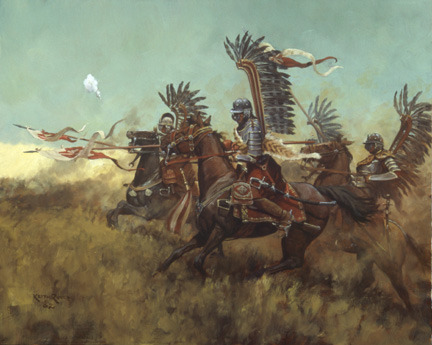amightydirge:Winged GloryThe Arms and Equipment of the Winged HussarsThe Winged Hussars were an elit
amightydirge:Winged GloryThe Arms and Equipment of the Winged HussarsThe Winged Hussars were an elite military unit of the Polish-Lithuanian Commonwealth. They were perhaps the greatest cavalry to have ever existed. They fought during a time when most armies had abandoned the point charge due to gunpowder weapons, yet, the Winged Hussars were rarely ever defeated. Their charges were absolutely devastating, and indifferent to gun and cannon and pike. The Winged Hussars were quite simply the final and ultimate evolution of the lancer. The Poles and the Lithuanians were a border people, living on the divide between East and West. Earlier, in the 10-12th Centuries, their cavalry fought like typical chivalric lancers of the West. However, the Mongol invasions under Batu Khan and Subutai saw such forces utterly crushed. Thus, by the 16th Century, the Winged Hussars had developed into a unique breed of cavalryman, tempered by influences from Mongol horse archers and heavy lancers, Serbian Hussars, and European point charge cavalry. One can easily see the cultural mixture by examining their arms and equipment. Their weaponry was highly diverse though their primary weapon was an incredibly long lance. The lance was actually hollowed out, making it light and allowing it to be made in such lengths. By some reports, the lances were longer than the pikes used by infantry, meaning that the Hussars could charge into Pike formations with impunity. Their charges were legendary, and their Hussar nature meant that they could steal upon the enemy quickly, and disengage with equal alacrity - mimicking the mobility of the earlier Mongol and Serbian horsemen. They were still well-armored, however, meaning that the Winged Hussars were a deadly hybrid of light and heavy cavalry. Besides the lance, the Winged Hussars used:- A sabre, known as the Szabla.- A long thrusting blade known as the Koncerz. - Recurve bows and arrows, showing influence from the Mongols, Turks, and Tartars. - As gunpowder was introduced, many riders carried several pistols to discharge at close range. Some used carbines, though the bow was always most favored for its beauty and grace. - Maces, axes, rider’s picks, and other armor-piercing weapons were also popular. The Hussars could expect to fight heavily armored opponents like the steel-plated Reiters of the Swedish and Prussians, or the heavy lancers of the Crimean Tatars and Ottoman Turks. Armor was often of a plate type, utilizing the highly advanced metallurgy skills of the 16th Century. It was, however, much lighter than earlier European plate, allowing the Hussars to reach incredible speeds. As guns became more and more potent, the Hussars would lighten their armor to increase their speed. Scale armor, however, was utilized as well. Their armor was ornately decorated, as most Winged Hussars were rich and wealthy. They often used leopard pelts as decoration. Their signature wings were purportedly made out of ostrich feathers attached to wooden frames. While not well known to the west, the Winged Hussars remain a symbol of Polish and Lithuanian pride, and rightfully so. During WWII, the 1st Polish Armored Division adopted the Winged Hussars as their symbol. The 1st Polish Armored Division would go on to be one of the deadliest armored units of the entire war. It was they who closed the Falaise Pocket, and held out against multiple SS divisions. The SS could never dislodge the Poles, and as a result, over 60,000 German soldiers were killed or captured, all but completely destroying the German 7th Army. -- source link

